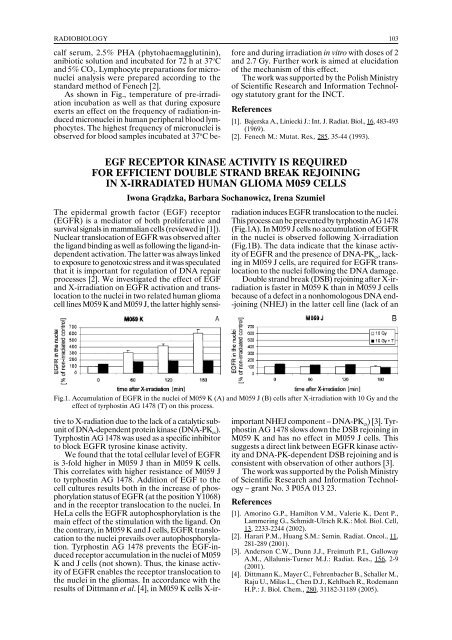annual report annual report annual report annual report 2005
annual report annual report annual report annual report 2005
annual report annual report annual report annual report 2005
Create successful ePaper yourself
Turn your PDF publications into a flip-book with our unique Google optimized e-Paper software.
RADIOBIOLOGY 103<br />
calf serum, 2.5% PHA (phytohaemagglutinin),<br />
anibiotic solution and incubated for 72 h at 37 o C<br />
and 5% CO 2 . Lymphocyte preparations for micronuclei<br />
analysis were prepared according to the<br />
standard method of Fenech [2].<br />
As shown in Fig., temperature of pre-irradiation<br />
incubation as well as that during exposure<br />
exerts an effect on the frequency of radiation-induced<br />
micronuclei in human peripheral blood lymphocytes.<br />
The highest frequency of micronuclei is<br />
observed for blood samples incubated at 37 o C before<br />
and during irradiation in vitro with doses of 2<br />
and 2.7 Gy. Further work is aimed at elucidation<br />
of the mechanism of this effect.<br />
The work was supported by the Polish Ministry<br />
of Scientific Research and Information Technology<br />
statutory grant for the INCT.<br />
References<br />
[1]. Bajerska A., Liniecki J.: Int. J. Radiat. Biol., 16, 483-493<br />
(1969).<br />
[2]. Fenech M.: Mutat. Res., 285, 35-44 (1993).<br />
EGF RECEPTOR KINASE ACTIVITY IS REQUIRED<br />
FOR EFFICIENT DOUBLE STRAND BREAK REJOINING<br />
IN X-IRRADIATED HUMAN GLIOMA M059 CELLS<br />
Iwona Grądzka, Barbara Sochanowicz, Irena Szumiel<br />
tive to X-radiation due to the lack of a catalytic subunit<br />
of DNA-dependent protein kinase (DNA-PK cs<br />
).<br />
Tyrphostin AG 1478 was used as a specific inhibitor<br />
to block EGFR tyrosine kinase activity.<br />
We found that the total cellular level of EGFR<br />
is 3-fold higher in M059 J than in M059 K cells.<br />
This correlates with higher resistance of M059 J<br />
to tyrphostin AG 1478. Addition of EGF to the<br />
cell cultures results both in the increase of phosphorylation<br />
status of EGFR (at the position Y1068)<br />
and in the receptor translocation to the nuclei. In<br />
HeLa cells the EGFR autophosphorylation is the<br />
main effect of the stimulation with the ligand. On<br />
the contrary, in M059 K and J cells, EGFR translocation<br />
to the nuclei prevails over autophosphorylation.<br />
Tyrphostin AG 1478 prevents the EGF-induced<br />
receptor accumulation in the nuclei of M059<br />
K and J cells (not shown). Thus, the kinase activity<br />
of EGFR enables the receptor translocation to<br />
the nuclei in the gliomas. In accordance with the<br />
results of Dittmann et al. [4], in M059 K cells X-irradiation<br />
induces EGFR translocation to the nuclei.<br />
This process can be prevented by tyrphostin AG 1478<br />
(Fig.1A). In M059 J cells no accumulation of EGFR<br />
in the nuclei is observed following X-irradiation<br />
(Fig.1B). The data indicate that the kinase activity<br />
of EGFR and the presence of DNA-PK cs<br />
, lacking<br />
in M059 J cells, are required for EGFR translocation<br />
to the nuclei following the DNA damage.<br />
Double strand break (DSB) rejoining after X-irradiation<br />
is faster in M059 K than in M059 J cells<br />
because of a defect in a nonhomologous DNA end-<br />
-joining (NHEJ) in the latter cell line (lack of an<br />
Fig.1. Accumulation of EGFR in the nuclei of M059 K (A) and M059 J (B) cells after X-irradiation with 10 Gy and the<br />
effect of tyrphostin AG 1478 (T) on this process.<br />
The epidermal growth factor (EGF) receptor<br />
(EGFR) is a mediator of both proliferative and<br />
survival signals in mammalian cells (reviewed in [1]).<br />
Nuclear translocation of EGFR was observed after<br />
the ligand binding as well as following the ligand-independent<br />
activation. The latter was always linked<br />
to exposure to genotoxic stress and it was speculated<br />
that it is important for regulation of DNA repair<br />
processes [2]. We investigated the effect of EGF<br />
and X-irradiation on EGFR activation and translocation<br />
to the nuclei in two related human glioma<br />
cell lines M059 K and M059 J, the latter highly sensi-<br />
important NHEJ component – DNA-PK cs ) [3]. Tyrphostin<br />
AG 1478 slows down the DSB rejoining in<br />
M059 K and has no effect in M059 J cells. This<br />
suggests a direct link between EGFR kinase activity<br />
and DNA-PK-dependent DSB rejoining and is<br />
consistent with observation of other authors [3].<br />
The work was supported by the Polish Ministry<br />
of Scientific Research and Information Technology<br />
– grant No. 3 P05A 013 23.<br />
References<br />
[1]. Amorino G.P., Hamilton V.M., Valerie K., Dent P.,<br />
Lammering G., Schmidt-Ulrich R.K.: Mol. Biol. Cell,<br />
13, 2233-2244 (2002).<br />
[2]. Harari P.M., Huang S.M.: Semin. Radiat. Oncol., 11,<br />
281-289 (2001).<br />
[3]. Anderson C.W., Dunn J.J., Freimuth P.I., Galloway<br />
A.M., Allalunis-Turner M.J.: Radiat. Res., 156, 2-9<br />
(2001).<br />
[4]. Dittmann K., Mayer C., Fehrenbacher B., Schaller M.,<br />
Raju U., Milas L., Chen D.J., Kehlbach R., Rodemann<br />
H.P.: J. Biol. Chem., 280, 31182-31189 (<strong>2005</strong>).
















